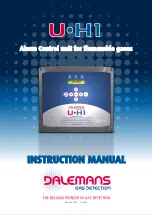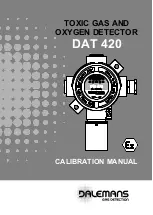
WT.050.130.000.UA.IM.1108
ACUTEC
™
35 SYSTEM
35
verified, immediately remove the bottle as prolonged exposure to high
concentrations of chlorine will shorten the life of the sensor. If no re-
sponse is observed, the sensor may need to be replaced. See paragraph
4.8, Troubleshooting.
4.2.3
Sulfur Dioxide Sensor Response Test
Sulfur Dioxide sensors can be tested with fresh powdered sodium bisulfite
placed in a squeeze bottle. A vapor of a few ppm can be squeezed toward
the sensor. If the sensor does not respond, it may need to be replaced.
See paragraph 4.8, Troubleshooting.
NOTE: If the sodium bisulfite is not fresh, it may not produce a high
enough concentration to test the sensor.
4.2.4
Ammonia Sensor Response Test
Ammonia sensors can be tested using ordinary ammonia solution used
for cleaning. Open a bottle of ammonia solution and carefully move the
mouth of the bottle near the sensor. Do not splash liquid ammonia solu-
tion on the sensor or it could damage the sensor. When the mouth of the
bottle is approximately one inch from the sensor, a rapid response should
be observed. Immediately remove the ammonia bottle as prolonged
exposure to high concentrations of ammonia will shorten the life of the
sensor. If the sensor does not respond it may need to be replaced. See
paragraph 4.8, Troubleshooting.
4.3
Sensor Replacement (See Dwg. 50.130.150.001)
Open the Transmitter and unplug the Sensor cable from the transmit-
ter circuit board. Unscrew the Sensor from the nut on the inside of the
enclosure and screw in the replacement Sensor.
Connect the new Sensor to the pins on the transmitter board and replace
the Transmitter cover. After a new Sensor has been connected, allow 12
hours for the new Sensor to completely stabilize. Then perform zero and
span adjustments as described in this section.
WARNING: THE GENERAL SENSOR RESPONSE TEST, AS DESCRIBED
ABOVE, MUST BE PERFORMED WHENEVER A NEW SENSOR IS IN-
STALLED.
NOTE: It is strongly recommended that sensors be powered over-
night upon initial startup before adjustments are made and before
connections are made to alarm relays. Sensors that are powered for
the first time may remain in an alarm state beyond the five-minute
inhibit period and may take several hours to fully stabilize.
!















































